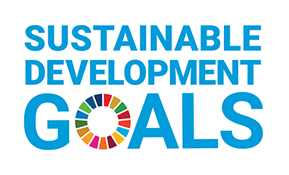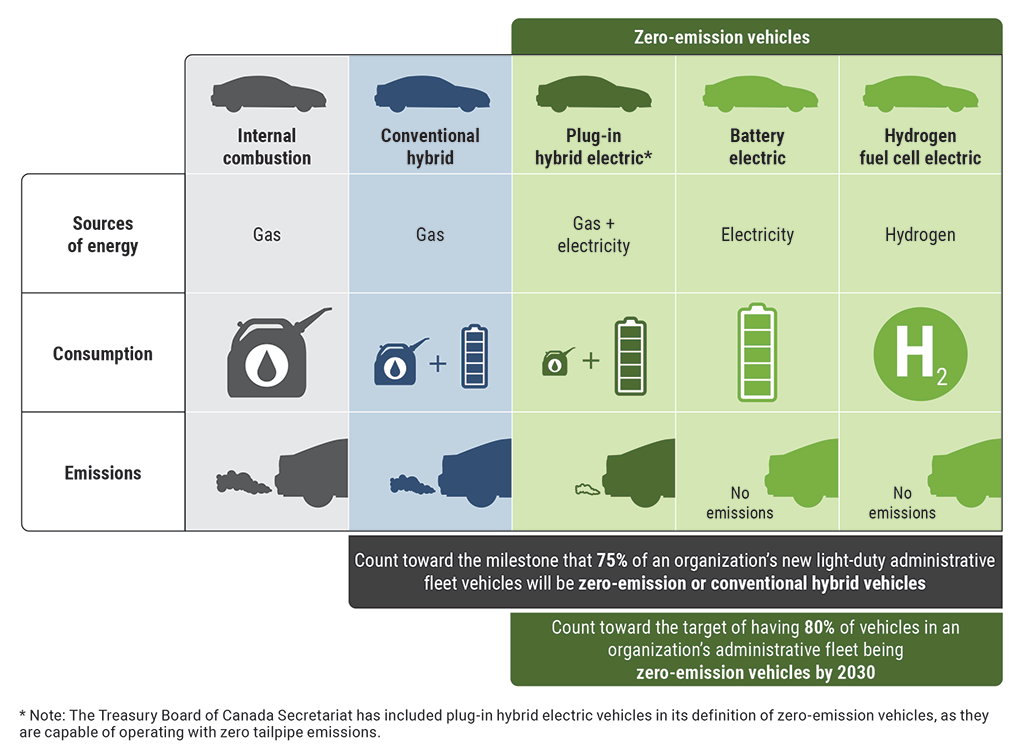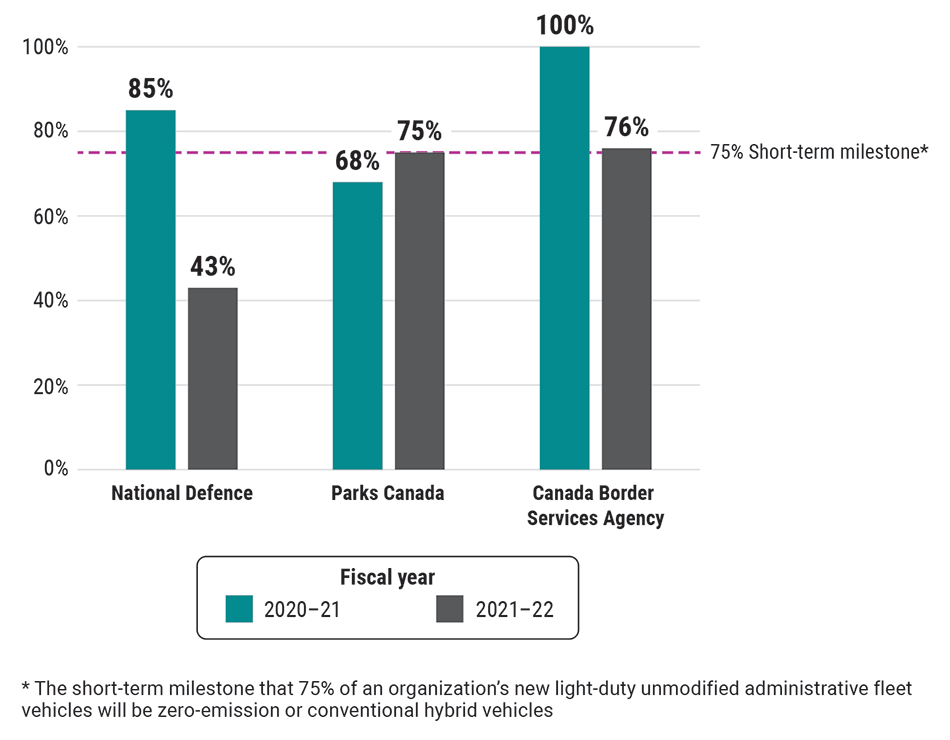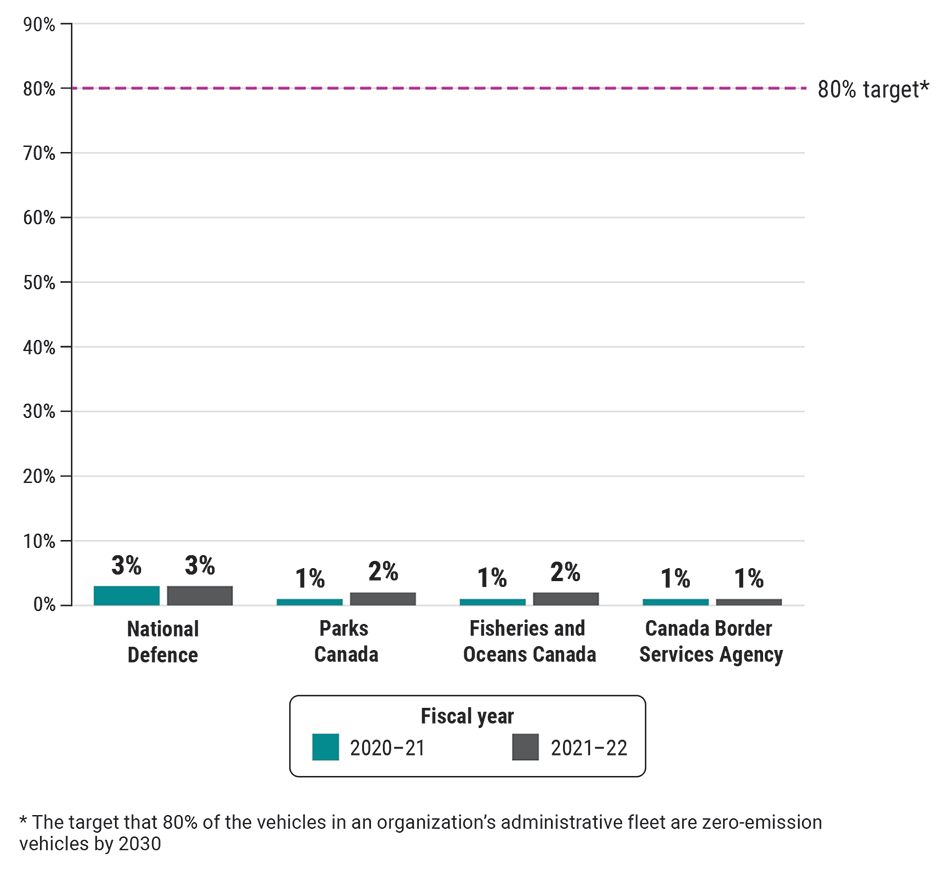2023 Reports 6 to 10 of the Commissioner of the Environment and Sustainable Development to the Parliament of Canada
Report 7—Departmental Progress in Implementing Sustainable Development Strategies—Zero-Emission Vehicles
At a Glance
Overall, National Defence, Parks Canada, Fisheries and Oceans Canada, and the Canada Border Services Agency contributed minimally to meeting the government’s target of 80% zero‑emission vehicles in the federal administrative fleet. While Parks Canada and the Canada Border Services Agency met the short-term milestone of making 75% of their vehicle purchases zero‑emission or conventional hybrid vehicles, the percentage of zero‑emission vehicles in all 4 organizations stood between 1% and 3% in 2022. These numbers make it unlikely that Canada will meet its target by 2030 as planned.
Out of the 27 federal organizations responsible for preparing departmental sustainable development strategies, we examined the 4 with the largest federal fleets—and with the highest potential for contributing to reducing greenhouse gas emissions. However, we found that none of the 4 organizations were strategic in their approaches to decarbonizing their fleets to meet the government’s target.
In addition, the sustainable development strategies of the 4 organizations provided limited information on how they were contributing to the United Nations’ Sustainable Development Goals. Increasing the number of zero‑emission vehicles in the federal administrative fleet not only contributes to the government’s broader goal of reducing emissions, but also demonstrates leadership toward Canada’s achievement of the United Nations’ 2030 Agenda for Sustainable Development and fight against climate change.
Key facts and findings
- The government has committed to net-zero emissions by 2050. The 2019–2022 Federal Sustainable Development Strategy has a target stating that the federal administrative fleet will comprise at least 80% zero‑emission vehicles by 2030.
- Zero-emission vehicles—battery electric, plug‑in hybrid electric, and hydrogen fuel cell electric vehicles—can operate without producing tailpipe emissions.
- As of 31 March 2022, for the whole of government, of the total 17,260 vehicles in the administrative fleet, 586 were zero‑emission vehicles (3%) and 1,267 were conventional hybrid vehicles (7%).
- There were external barriers that have affected the selected organizations’ ability to acquire zero‑emission vehicles, such as their limited availability.
Why we did this audit
- Increasing the proportion of zero‑emission vehicles in the federal administrative fleet not only contributes to the government’s broader goal of reducing emissions, but also demonstrates leadership in fighting climate change.
- By developing and reporting on departmental sustainable development strategies, federal organizations can demonstrate this leadership and highlight what steps must still be taken in their actions to achieve lower emissions.
- Replacing conventional internal combustion engine vehicles with zero‑emission vehicles will contribute to reducing greenhouse gas emissions.
- The federal government expects federal organizations to contribute to achieving the United Nations’ Sustainable Development Goals within their areas of responsibility.
Highlights of our recommendations
- National Defence, Parks Canada, Fisheries and Oceans Canada, and the Canada Border Services Agency should develop strategic approaches to decarbonizing their fleets and expedite their implementation.
- National Defence, Parks Canada, Fisheries and Oceans Canada, and the Canada Border Services Agency should report in their departmental sustainable development strategy reports the numbers and percentages of zero‑emission vehicles (including battery electric, plug-in hybrid electric, and hydrogen fuel cell electric) and conventional hybrid vehicles in their administrative fleets separately, in addition to the yearly procurement totals of these types of vehicles.
Please see the full report to read our complete findings, analysis, recommendations and the audited organizations’ responses.


In 2015, Canada committed to achieving the United Nations’ 2030 Agenda for Sustainable Development, which includes 17 Sustainable Development Goals. Goal 12 (Responsible Consumption and Production) calls for signatories to do the following: “Promote public procurement practices that are sustainable, in accordance with national policies and priorities.” The government’s commitment to replacing its vehicle fleet with zero‑emission vehicles relates directly to this goal and to Goal 13 (Climate Action). All federal ministers and organizations are accountable for implementing the 2030 Agenda for Sustainable Development and the Sustainable Development Goals within their areas of responsibility.
Visit our Sustainable Development page to learn more about sustainable development and the Office of the Auditor General of CanadaOAG.
Exhibit highlights
Types of vehicle powertrain technologies, according to the Treasury Board of Canada Secretariat

Source: Adapted from information from the Treasury Board of Canada Secretariat
Text version
This illustration shows 5 types of vehicle powertrain technologies and their sources of energy, their consumption, and their amounts of emissions.
The first type is internal combustion technology. The source of energy for an internal combustion vehicle is gas. This vehicle consumes gas, and it emits a large amount of emissions.
The second type is conventional hybrid technology. The source of energy for a conventional hybrid vehicle is gas. This vehicle consumes gas and electricity, and it emits a moderate amount of emissions.
The last 3 types are the plug‑in hybrid electric, battery electric, and hydrogen fuel cell electric technologies. Vehicles that use these technologies are considered zero‑emission vehicles.
The sources of energy for a plug‑in hybrid electric vehicle are gas and electricity. This vehicle consumes gas and electricity, and it emits almost no emissions. The Treasury Board of Canada Secretariat has included plug‑in hybrid electric vehicles in its definition of zero‑emission vehicles, as they are capable of operating with zero tailpipe emissions.
The source of energy for a battery electric vehicle is electricity. This vehicle consumes electricity, and it emits no emissions.
The source of energy for a hydrogen fuel cell electric vehicle is hydrogen. This vehicle consumes hydrogen, and it emits no emissions.
Conventional hybrid vehicles and the 3 zero‑emission vehicles—that is, plug‑in hybrid electric, battery electric, and hydrogen fuel cell electric vehicles—count toward the milestone that 75% of an organization’s new light‑duty administrative fleet vehicles will be zero‑emission or conventional hybrid vehicles.
The 3 zero-emission vehicles—that is, plug‑in hybrid electric, battery electric, and hydrogen fuel cell electric vehicles—count toward the target of having 80% of vehicles in an organization’s administrative fleet being zero‑emission vehicles by 2030.
Some percentages of vehicle purchases that were zero‑emission or conventional hybrid vehicles did not meet the short‑term milestone of 75%

Note: Fisheries and Oceans Canada did not report on the percentage of its vehicle purchases that were zero‑emission or conventional hybrid vehicles.
Source: Departmental sustainable development strategy reports
Text version
This bar chart shows the percentages of vehicle purchases that were zero‑emission or conventional hybrid vehicles at National Defence, Parks Canada, and the Canada Border Services Agency in the 2020–21 and 2021–22 fiscal years. Fisheries and Oceans Canada did not report on the percentage of its vehicle purchases that were zero‑emission or conventional hybrid vehicles.
Only the Canada Border Services Agency met the short-term milestone of 75% in both years—that is, that 75% of an organization’s new light‑duty unmodified administrative fleet vehicles will be zero‑emission or conventional hybrid vehicles. In 2020–21, 100% of the agency’s vehicle purchases were zero‑emission or conventional hybrid vehicles, while in 2021–22, 76% were.
National Defence met the short-term milestone of 75% in 2020–21 but did not meet it in 2021–22. In 2020–21, 85% of the department’s vehicle purchases were zero-emission or conventional hybrid vehicles, while in 2021–22, 43% were.
Parks Canada did not meet the short-term milestone of 75% in 2020–21 but did meet it in 2021–22. In 2020–21, 68% of the agency’s vehicle purchases were zero‑emission or conventional hybrid vehicles, while in 2021–22, 75% were.
Percentages of zero‑emission vehicles in federal administrative fleets were well below the government’s 2030 target of 80%

Source: Data from the selected federal organizations
Text version
This bar chart shows the percentages of zero-emission vehicles in the administrative fleets of National Defence, Parks Canada, Fisheries and Oceans Canada, and the Canada Border Services Agency in the 2020–21 and 2021–22 fiscal years. The percentages for the 4 fleets ranged from only 1% to 3%, which were well below the target that 80% of the vehicles in an organization’s administrative fleet are zero‑emission vehicles by 2030.
At National Defence, 3% of vehicles in its fleet were zero‑emission vehicles in both 2020–21 and 2021–22.
At Parks Canada, 1% of vehicles in its fleet were zero‑emission vehicles in 2020–21, while 2% were in 2021–22.
At Fisheries and Oceans Canada, 1% of vehicles in its fleet were zero‑emission vehicles in 2020–21, while 2% were in 2021–22.
At the Canada Border Services Agency, 1% of vehicles in its fleet were zero‑emission vehicles in both 2020–21 and 2021–22.
Infographic

Text version
Zero-Emission Vehicles and Charging Infrastructure
The Government of Canada has committed to reducing greenhouse gas emissions by 40% to 45% below 2005 levels by 2030. Zero‑emission vehicles will be an essential part of achieving this goal.
Twenty-two percent of greenhouse gas emissions are produced from transportation. Greenhouse gas emissions are also produced from oil and gas (28%), buildings (13%), heavy industry (12%), agriculture (10%), electricity (8%), and waste and other sources (7%). Of the greenhouse gas emissions produced from transportation, 51% are from light‑duty vehicles, 27% are from heavy‑duty vehicles, and 22% are from other vehicles. (The source of this data is the National Inventory Report 1990–2021: Greenhouse Gas Sources and Sinks in Canada, Environment and Climate Change Canada, 2023.)
As part of the solution, the federal government requires all new light‑duty vehicles sold in Canada to be zero emission by 2035.
Zero-emission vehicles include plug‑in hybrid electric vehicles, whose sources of energy are gas and electricity; battery electric vehicles, whose source of energy is electricity; and hydrogen fuel cell electric vehicles, whose source of energy is hydrogen. Plug‑in hybrid electric vehicles have low emissions, while battery electric and hydrogen fuel cell electric vehicles have no emissions.
Vehicles not to be sold after 2035 include internal combustion vehicles, whose source of energy is gas, and conventional hybrid vehicles, whose sources of energy are gas and electricity. Both types of vehicles have high emissions.
Two audits
Two audits were conducted: The Zero Emission Vehicle Infrastructure Program and Departmental Progress in Implementing Sustainable Development Strategies—Zero-Emission Vehicles.
The Zero Emission Vehicle Infrastructure Program
This audit looked at increasing Canadians’ access to reliable electric vehicle charging.
Natural Resources Canada is on track to meet its target of 33,500 charging port installations by 2026. There are 6,654 operational ports, 27,233 ports under construction, 33,500 ports in the program target, and 33,887 funded ports.
There are 3 types of electric vehicle charging ports: Level 1, Level 2, and Level 3. Chargers funded by the program are those with Level 2 and Level 3 charging ports. Level 1 charging ports are used in private homes. Level 2 charging ports are used at residential buildings, in public places, and at workplaces. Level 3 charging ports are used at dedicated stations, in public spaces, in commercial fleets, and along highways.
Charging stations are located at workplaces (such as an office building), in public places (such as a parking garage), at residential buildings (such as an apartment building), and at fleet operations (such as a taxi stand).
The department’s approach did not include how or when underserved areas, such as remote and Indigenous communities, would have access to charging stations.
Departmental Progress in Implementing Sustainable Development Strategies—Zero‑Emission Vehicles
This audit assessed whether selected federal organizations bought enough zero‑emission vehicles to meet the target under the Greening Government goal.
The following administrative fleets were audited: National Defence (6,465 vehicles), Parks Canada (1,665 vehicles), Fisheries and Oceans Canada (1,337 vehicles), and the Canada Border Services Agency (1,113 vehicles).
As of March 2022, 3% of vehicles were zero emission across the entire government fleet, while 7% were conventional hybrid. The zero‑emission vehicle target is 80% of the fleet.
None of the 4 organizations were strategic in their approaches to decarbonizing their fleets to meet the government’s target. Buying conventional hybrid vehicles will not lead to meeting the 80% target and will not reduce the level of emissions as much as zero-emission vehicles.
Barriers include the lack of available zero‑emission vehicles, the lack of specialized zero‑emission vehicles, and an unavailable charging infrastructure.
Increasing the number of zero-emission vehicles in the federal administrative fleet not only contributes to reducing emissions, but also demonstrates leadership toward the achievement of the United Nations’ Sustainable Development Goals and the fight against climate change.
The move toward electric vehicles is only one piece of the puzzle toward a zero‑emission future.
Related information
Entities
Tabling date
- 7 November 2023
Related audits
- 2023 Reports of the Commissioner of the Environment and Sustainable Development to the Parliament of Canada
Report 8—The Zero Emission Vehicle Infrastructure Program—Natural Resources Canada - 2022 Reports of the Commissioner of the Environment and Sustainable Development to the Parliament of Canada
Report 3—Hydrogen’s Potential to Reduce Greenhouse Gas Emissions - 2022 Reports of the Commissioner of the Environment and Sustainable Development to the Parliament of Canada
Report 2—Greening Government Strategy - 2022 Reports of the Commissioner of the Environment and Sustainable Development to the Parliament of Canada
Report 1—Just Transition to a Low-Carbon Economy
